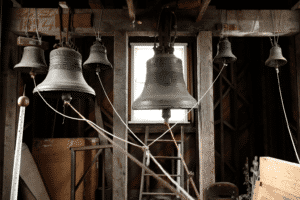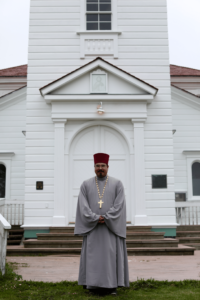Interwoven: How the Russian Orthodox Church Adopted Unangax̂ Traditions
Interwoven
The onion-shaped green domes of the Holy Ascension of our Lord Russian Orthodox Cathedral (Russian: Церковь Вознесения Господня) tower above the Aleutian town of Unalaska. Inside, ornate portraits of Orthodox saints, called icons, decorate the walls. At first, one might be tempted to see the Cathedral as an outpost from a faraway European institution, out of place among the wind-swept mountains and wild coastlines of the Aleutian Islands. 
Not so, says father Evon Bereskin. With soft-spoken excitement, Bereskin, who is Unangax̂, explains the ways that, for over two hundred years, the Russian Orthodox Church has become deeply interwoven with traditional Unangax̂ ways of life. The Church, he says, played a key role in preserving Unangax̂ history, and it not only changed the culture but has absorbed and been changed by it as well. In the present, Bereskin sees the church playing a role in spreading Unangax̂ culture to the world.
The history of the Russian Orthodox Church began in Alaska, Bereskin explains, with Russian fur traders in the late 1700s. “When they came here, they settled among the Unangax̂ people. And when they did, they married Unangax̂ women. And they baptized their children.”
In 1824, Father John Veniaminof arrived in Unalaska from Irkutsk, Russia. When he arrived, Bereskin says, a local chief told the Father that two angelic figures had been visiting him and preparing him for the Father’s arrival. The strong moral traditions of the Unangax̂ people and their early exposure to the Orthodox faith made the residents of Unalaska eager to learn from Veniaminof.
The desire to learn was mutual. As Veniaminof taught the people of Unalaska about the Russian Orthodox faith, he also learned to speak Unangam Tunuu and was able to teach in the local language. Along with others, Veniaminof helped develop the first written language, using the Cyrillic alphabet. Veniaminof translated the gospels into Unangam Tunuu, provided a tool to help record oral history, and helped Unalaska residents become literate.
“For the first time in our almost four-thousand-year history,” Bereskin beams, “we were able to read and write in our own language.”
![]() Shortly after arriving in Unalaska, Veniaminof led efforts to rebuild the Cathedral, replacing an earlier octagonal structure built by Russian traders. The Cathedral was rebuilt in 1896 and is perhaps the most iconic landmark in Unalaska to this day. Among the Cathedral’s most prized possessions is an icon gifted by Tsar Nicolas II, commissioned specifically for the church in Unalaska. Another icon, exquisitely crafted in wood and gilded with silver, was presented to the Cathedral by Catherine the Great.
Shortly after arriving in Unalaska, Veniaminof led efforts to rebuild the Cathedral, replacing an earlier octagonal structure built by Russian traders. The Cathedral was rebuilt in 1896 and is perhaps the most iconic landmark in Unalaska to this day. Among the Cathedral’s most prized possessions is an icon gifted by Tsar Nicolas II, commissioned specifically for the church in Unalaska. Another icon, exquisitely crafted in wood and gilded with silver, was presented to the Cathedral by Catherine the Great.
Inside the Cathedral, one row of icons is visibly darker than others. Bereskin explains that when residents of Unalaska were forcibly evacuated in 1942 due to the invasion of the Aleutian Islands by the Japanese, devoted church members immediately went to the Cathedral to make sure that precious items were preserved. “Their faith in God was so great that coming to church was the first priority, to take down what they needed for the church to preserve and protect them.”
Some items, such as chandeliers, were buried, while the cloth icons had to be rolled up and taken off the island for safekeeping. However, the humid weather in Southeast Alaska, where the residents of Unalaska were interned during the course of the war, caused mold to form on some of the icons. Efforts over following decades to protect or restore the damaged items with oil and shellac had stopped the mold, but left them darkened and delicate. The icons in the church are now both representations of religious figures and a reflection of the history and determination of the Unangax̂ people.
Though many of the items in the Cathedral are familiar parts of Russian Orthodoxy, others show that the flow of culture here has run in both directions. On one wall, a row of icons are capped with seal whiskers. Bereskin explains that seal whiskers are a sign of hunting prowess in Unangax̂ culture, and adorning the icons with the whiskers was a way to confer respect on them. Other items of religious importance have been crafted out of traditional materials, such as seal skin and seal guts. In this way, Russian Orthodoxy has not only changed traditional Unangax̂ culture but has also been enriched by it.

Interior of Bell Tower, Unalaska
Father Bereskin says he is not the first Unangax̂ priest, and that he does not believe he’ll be the last. A resident of Unalaska, Bereskin grew up in the church. “Even when there was no priest, my mother would bring me to church on Sundays,” he says, describing his mother’s devotion to his religious upbringing. “I didn’t know how to sing or anything but my mom would hand me the book and say ‘here, follow along’.”
At age five, he began serving as an alter server, readying candles, cutting bread, and heating water. He attended seminary in 2001, was ordained a deacon in February 2007, and in June of that year became a priest. Though Russian Orthodox priests typically serve in a community other than the one they grew up in, the church made an exception for Bereskin. He, along with his wife and two daughters, were sent back to Unalaska.
“’Man proposes, and God disposes,’” he laughs. “And so, I’ve really come to accept the fact that I’m here. It’s obviously the will of God. Otherwise, I wouldn’t be here with my family.” Though living in one’s own community poses challenges, he says, he is proud that he is “able to tell our part of our story, as an Unangax̂ priest.”
That story, Bereskin says, is now spreading in ways that those living in previous decades could never have imagined. Just as Father Veniaminof helped preserve and spread Unangax̂ culture through written and oral means, new media tools like audio, video, and the internet allow messages to radiate out from the Aleutian Islands like never before.
“Our stories are able to move across to a broader range of people now because of the technology,” Bereskin says with excitement. “Our stories could be told in South Africa, or Japan or somewhere. To be part of it is a great joy and an honor, to be part of this great undertaking for our stories to be told and our faith and our culture to be shared with the world.”
Bereskin is positive about the direction of his community and his church. Unalaska is a more diverse place now, he says, and that diversity is increasingly reflected in the pews. The idea that the Russian Orthodox church is a “Native Church” persists, but is more and more a thing of the past.
“This is the Orthodox Church,” he says, warmly. “The doors are open to everyone.”

